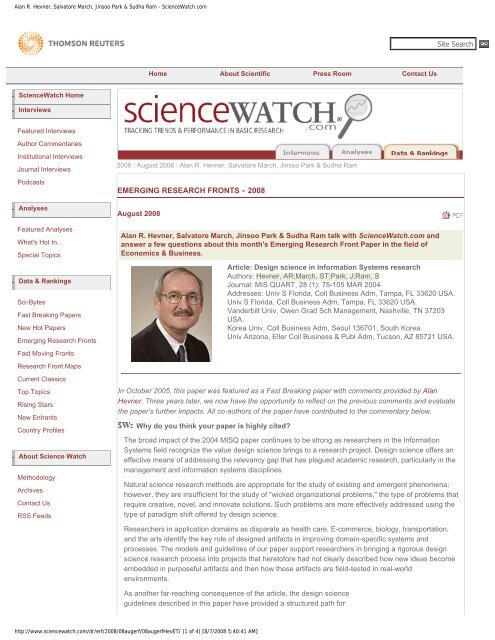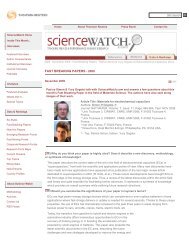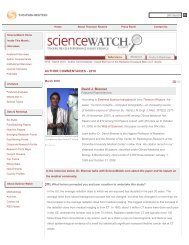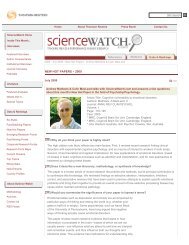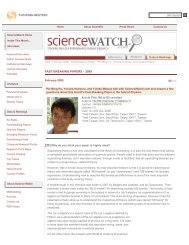Alan R. Hevner, Salvatore March, Jinsoo Park & Sudha Ram ...
Alan R. Hevner, Salvatore March, Jinsoo Park & Sudha Ram ...
Alan R. Hevner, Salvatore March, Jinsoo Park & Sudha Ram ...
Create successful ePaper yourself
Turn your PDF publications into a flip-book with our unique Google optimized e-Paper software.
<strong>Alan</strong> R. <strong>Hevner</strong>, <strong>Salvatore</strong> <strong>March</strong>, <strong>Jinsoo</strong> <strong>Park</strong> & <strong>Sudha</strong> <strong>Ram</strong> - ScienceWatch.com<br />
Home About Scientific Press Room Contact Us<br />
●<br />
●<br />
ScienceWatch Home<br />
Interviews<br />
Featured Interviews<br />
Author Commentaries<br />
Institutional Interviews<br />
Journal Interviews<br />
Podcasts<br />
2008 : August 2008 : <strong>Alan</strong> R. <strong>Hevner</strong>, <strong>Salvatore</strong> <strong>March</strong>, <strong>Jinsoo</strong> <strong>Park</strong> & <strong>Sudha</strong> <strong>Ram</strong><br />
EMERGING RESEARCH FRONTS - 2008<br />
●<br />
Analyses<br />
August 2008<br />
●<br />
●<br />
Featured Analyses<br />
What's Hot In...<br />
Special Topics<br />
Data & Rankings<br />
Sci-Bytes<br />
Fast Breaking Papers<br />
New Hot Papers<br />
Emerging Research Fronts<br />
Fast Moving Fronts<br />
Research Front Maps<br />
Current Classics<br />
Top Topics<br />
Rising Stars<br />
New Entrants<br />
Country Profiles<br />
About Science Watch<br />
Methodology<br />
Archives<br />
Contact Us<br />
RSS Feeds<br />
<strong>Alan</strong> R. <strong>Hevner</strong>, <strong>Salvatore</strong> <strong>March</strong>, <strong>Jinsoo</strong> <strong>Park</strong> & <strong>Sudha</strong> <strong>Ram</strong> talk with ScienceWatch.com and<br />
answer a few questions about this month's Emerging Research Front Paper in the field of<br />
Economics & Business.<br />
Article: Design science in Information Systems research<br />
Authors: <strong>Hevner</strong>, AR;<strong>March</strong>, ST;<strong>Park</strong>, J;<strong>Ram</strong>, S<br />
Journal: MIS QUART, 28 (1): 75-105 MAR 2004<br />
Addresses: Univ S Florida, Coll Business Adm, Tampa, FL 33620 USA.<br />
Univ S Florida, Coll Business Adm, Tampa, FL 33620 USA.<br />
Vanderbilt Univ, Owen Grad Sch Management, Nashville, TN 37203<br />
USA.<br />
Korea Univ, Coll Business Adm, Seoul 136701, South Korea.<br />
Univ Arizona, Eller Coll Business & Publ Adm, Tucson, AZ 85721 USA.<br />
In October 2005, this paper was featured as a Fast Breaking paper with comments provided by <strong>Alan</strong><br />
<strong>Hevner</strong>. Three years later, we now have the opportunity to reflect on the previous comments and evaluate<br />
the paper's further impacts. All co-authors of the paper have contributed to the commentary below.<br />
Why do you think your paper is highly cited?<br />
The broad impact of the 2004 MISQ paper continues to be strong as researchers in the Information<br />
Systems field recognize the value design science brings to a research project. Design science offers an<br />
effective means of addressing the relevancy gap that has plagued academic research, particularly in the<br />
management and information systems disciplines.<br />
Natural science research methods are appropriate for the study of existing and emergent phenomena;<br />
however, they are insufficient for the study of "wicked organizational problems," the type of problems that<br />
require creative, novel, and innovate solutions. Such problems are more effectively addressed using the<br />
type of paradigm shift offered by design science.<br />
Researchers in application domains as disparate as health care, E-commerce, biology, transportation,<br />
and the arts identify the key role of designed artifacts in improving domain-specific systems and<br />
processes. The models and guidelines of our paper support researchers in bringing a rigorous design<br />
science research process into projects that heretofore had not clearly described how new ideas become<br />
embedded in purposeful artifacts and then how those artifacts are field-tested in real-world<br />
environments.<br />
As another far-reaching consequence of the article, the design science<br />
guidelines described in this paper have provided a structured path for<br />
http://www.sciencewatch.com/dr/erf/2008/08augerf/08augerfHevET/ (1 of 4) [8/7/2008 5:40:41 AM]
<strong>Alan</strong> R. <strong>Hevner</strong>, <strong>Salvatore</strong> <strong>March</strong>, <strong>Jinsoo</strong> <strong>Park</strong> & <strong>Sudha</strong> <strong>Ram</strong> - ScienceWatch.com<br />
doctoral students interested in using this methodology in their research;<br />
structuring, and legitimizing of their research.<br />
Does it describe a new discovery, methodology, or synthesis of<br />
knowledge?<br />
As previously described, our goal in the paper is to position design science<br />
research in the IS field as an equal, complementary partner to the more<br />
prevalent behavioral science research paradigm. The key contribution is a<br />
new way of thinking about what makes IS research relevant to its various<br />
audiences of managers, practitioners, and peer researchers in related fields.<br />
Design must be informed by appropriate theories that explain or predict<br />
human behavior; however, these may be insufficient to enable the<br />
development and adaptation of effective organizational artifacts.<br />
Scientific theories may explain existing or emergent organizational<br />
phenomena related to extant organizational forms and artifacts but they<br />
cannot account for the qualitative novelty achieved by human intention,<br />
creativity, and innovation in the design and appropriation of such artifacts.<br />
That is, science, the process of understanding "what is," may be insufficient<br />
for design, the process of understanding "what can be."<br />
Coauthor<br />
<strong>Salvatore</strong> <strong>March</strong><br />
How would you summarize the significance of your paper in<br />
layman's terms?<br />
Upon further reflection, we would add that the paper has significance due to<br />
the natural desire of researchers to improve things. For some, it is not<br />
enough to study and understand why nature is as it is, but we also want to<br />
know how we can improve the way it is. Design science research attempts<br />
to focus creativity into the design and construction of artifacts that have<br />
utility in application environments.<br />
Coauthor<br />
<strong>Jinsoo</strong> <strong>Park</strong><br />
Design as a research paradigm focuses on the construction and evaluation<br />
of novel artifacts that enable the solution of important problems for which<br />
extant theory and design knowledge are inadequate. It utilizes theory and<br />
design knowledge but is fundamentally a creative activity in which<br />
knowledge is acquired through the building and use of novel problemsolving<br />
artifacts. That knowledge must be tested through the evaluation of<br />
the produced artifact.<br />
Rigorous testing results in a demonstration that the design can be utilized to<br />
solve real problems. Designs have no special dispensation from the laws of<br />
nature. Hence, natural science research methods are utilized to gain an<br />
understanding of why a design works and to specify contingencies upon it.<br />
The resultant theories provide principles that can then become part of the<br />
"best practice." However, because organizations and the environments in<br />
which they operate are social constructions, such "design theories" are<br />
perishable. That is, they are subject to change as the social reality changes.<br />
Coauthor<br />
<strong>Sudha</strong> <strong>Ram</strong><br />
There may, in fact, be no immutable "laws of organizational design" to be discovered and codified. The<br />
significance of this observation for academic researchers is that they must constantly challenge the<br />
assumptions that have characterized research in the management disciplines and they must recognize<br />
that creativity, innovation, and qualitative novelty are a significant part of the phenomena they study.<br />
How did you become involved in this research and were any particular problems encountered<br />
along the way?<br />
The four authors and most of our doctoral students have followed the design science methodology<br />
implicitly, so this paper was a natural outcome of our experiences over the past three decades. With<br />
science and engineering backgrounds, design seemed a natural mode of conducting research intended<br />
to affect practice. Design is fundamental to the management disciplines. Managers are engaged in the<br />
design and implementation of business systems aimed at improving organizational performance.<br />
A manager's professional responsibility is to transform existing situations into preferred ones, to shape<br />
social organizations and economic processes, and to create value. Yet research in the management<br />
disciplines has been based primarily on the natural science paradigm. This has been attributed to the<br />
http://www.sciencewatch.com/dr/erf/2008/08augerf/08augerfHevET/ (2 of 4) [8/7/2008 5:40:41 AM]
<strong>Alan</strong> R. <strong>Hevner</strong>, <strong>Salvatore</strong> <strong>March</strong>, <strong>Jinsoo</strong> <strong>Park</strong> & <strong>Sudha</strong> <strong>Ram</strong> - ScienceWatch.com<br />
absorption of management schools into the general culture of the university where the natural science<br />
paradigm is the norm for academic research. Overcoming this bias toward the natural science paradigm<br />
has been and continues to be a challenge.<br />
Where do you see your research leading in the future?<br />
The broadening recognition of design science research in the IS field has led to a number of important<br />
new activities and research directions:<br />
●<br />
A new, multi-disciplinary research conference, Design Science Research in Information Systems &<br />
Technology (DESRIST), has been established and three offerings of the conference have been held<br />
from 2006 to 2008.<br />
● A special issue of MISQ on Design Science Research will appear in 2008.<br />
●<br />
Most IS doctoral programs in major universities now provide a research seminar dedicated to design<br />
science research methods and projects.<br />
● Leading international scholars in IS are actively extending the research ideas found in the 2004<br />
MISQ paper.<br />
●<br />
●<br />
●<br />
●<br />
Examples are:<br />
S Gregor and D Jones, "The Anatomy of a Design Theory," Journal of the AIS 8[5], 312-35, May<br />
2007.<br />
Iivari J, "A Paradigmatic Analysis of Information Systems as a Design Science," Scandinavian<br />
Journal of Information Systems 19[2], 2007.<br />
Peffers K, et al., "A Design Science Research Methodology for Information Systems Research,"<br />
Journal of Management Information Systems 24[3], 45-77, Winter 2008.<br />
"The broad<br />
impact of<br />
the 2004<br />
MISQ<br />
paper<br />
continues<br />
to be<br />
strong as<br />
researchers<br />
in the<br />
Information<br />
Systems<br />
field<br />
recognize<br />
the value<br />
design<br />
science<br />
brings to a<br />
research<br />
project."<br />
Leading research journals and conferences in the IS field are openly soliciting top-quality<br />
design science research contributions and are expanding their boards to include more<br />
senior editors and associate editors who have used and understand the design science<br />
approach. This will ultimately pave the way for more design science research papers to<br />
be published and thus benefit the whole field by enhancing the relevance of IS research.<br />
We are excited by the ongoing discussions and increased interest in design science<br />
research projects in the IS field. Information systems and organizational routines are<br />
among the key components of organizational design as they are extensions of human<br />
cognitive capabilities. These are the tools of knowledge working to enable new<br />
organizational forms and provide management and decision-making support.<br />
For example, incentive structures related to job performance such as achieving sales,<br />
product quality, or customer satisfaction goals require information gathering and analysis<br />
capabilities. Management of outsourcing and inter-organizational partnerships requires<br />
secure information sharing. Identification of problems and opportunities requires the<br />
gathering and analysis of business intelligence.<br />
More and more frequently, business decisions are made based on a computer-based<br />
analysis and subsequent recommendations. Similarly, organizational routines are<br />
intended to provide guidance to human action within prescribed organizational contexts.<br />
Yet, even these artifacts are appropriated and adapted by humans in ways and for<br />
purposes which the designers may not have envisioned. With the renewed interest in<br />
design science research in the information systems and organizational science<br />
disciplines, future research will focus on the co-design of information processing<br />
capabilities and organizational structures.<br />
Do you foresee any social or political implications of your research?<br />
With a goal of improving societal and organizational environments, it is clear that design science<br />
research does include many social and political implications. Iivari (2007) discusses in some detail the<br />
ethical responsibilities of a design scientist for the consequences of the research process and results<br />
(the designed artifacts). He encourages the questioning of the values of a design science research<br />
project.<br />
Whose interests are served by the improvements introduced into an environment by these design<br />
artifacts? Are other groups disadvantaged by these new artifacts? The values underlying design science<br />
http://www.sciencewatch.com/dr/erf/2008/08augerf/08augerfHevET/ (3 of 4) [8/7/2008 5:40:41 AM]
<strong>Alan</strong> R. <strong>Hevner</strong>, <strong>Salvatore</strong> <strong>March</strong>, <strong>Jinsoo</strong> <strong>Park</strong> & <strong>Sudha</strong> <strong>Ram</strong> - ScienceWatch.com<br />
research must be made as transparent as possible, in order to evaluate the social and political impacts<br />
of the research.<br />
Governments and societies are social constructions, artifacts designed to achieve human goals,<br />
purposes, and intentions, influenced by and operating within the context of emergent and intentional<br />
human behavior. As information technology artifacts enable new organizational forms in business they<br />
enable new forms in government and in society as a whole.<br />
Designers must be concerned about the unintended effects of artifacts they have developed. Information<br />
technology artifacts such as the Internet, electronic social networks, communication media, electronic<br />
commerce, and large-scale electronic collaboration systems have had significant positive and negative<br />
impacts on government and society. They have made government more accessible and have also<br />
greatly improved the availability of information. Yet they raise serious privacy and security concerns.<br />
These are issues that researchers working in the field of design science must address.<br />
<strong>Alan</strong> R. <strong>Hevner</strong><br />
University of South Florida<br />
Tampa, FL, USA<br />
<strong>Salvatore</strong> <strong>March</strong><br />
Vanderbilt University<br />
Nashville, TN, USA<br />
<strong>Jinsoo</strong> <strong>Park</strong><br />
Seoul National University<br />
Seoul, KOREA<br />
<strong>Sudha</strong> <strong>Ram</strong><br />
University of Arizona<br />
Tucson, AZ, USA<br />
Keywords: design science, design science methodology, design theories, information systems, development<br />
adaptation effective organizational artifacts, emergent organizational phenomena, natural science research methods,<br />
natural science paradigms, laws organizational design, information technology artifacts.<br />
back to top<br />
2008 : August 2008 : <strong>Alan</strong> R. <strong>Hevner</strong>, <strong>Salvatore</strong> <strong>March</strong>, <strong>Jinsoo</strong> <strong>Park</strong> & <strong>Sudha</strong> <strong>Ram</strong><br />
Scientific Home | About Scientific | Site Search | Site Map<br />
Copyright Notices | Terms of Use | Privacy Statement<br />
http://www.sciencewatch.com/dr/erf/2008/08augerf/08augerfHevET/ (4 of 4) [8/7/2008 5:40:41 AM]


